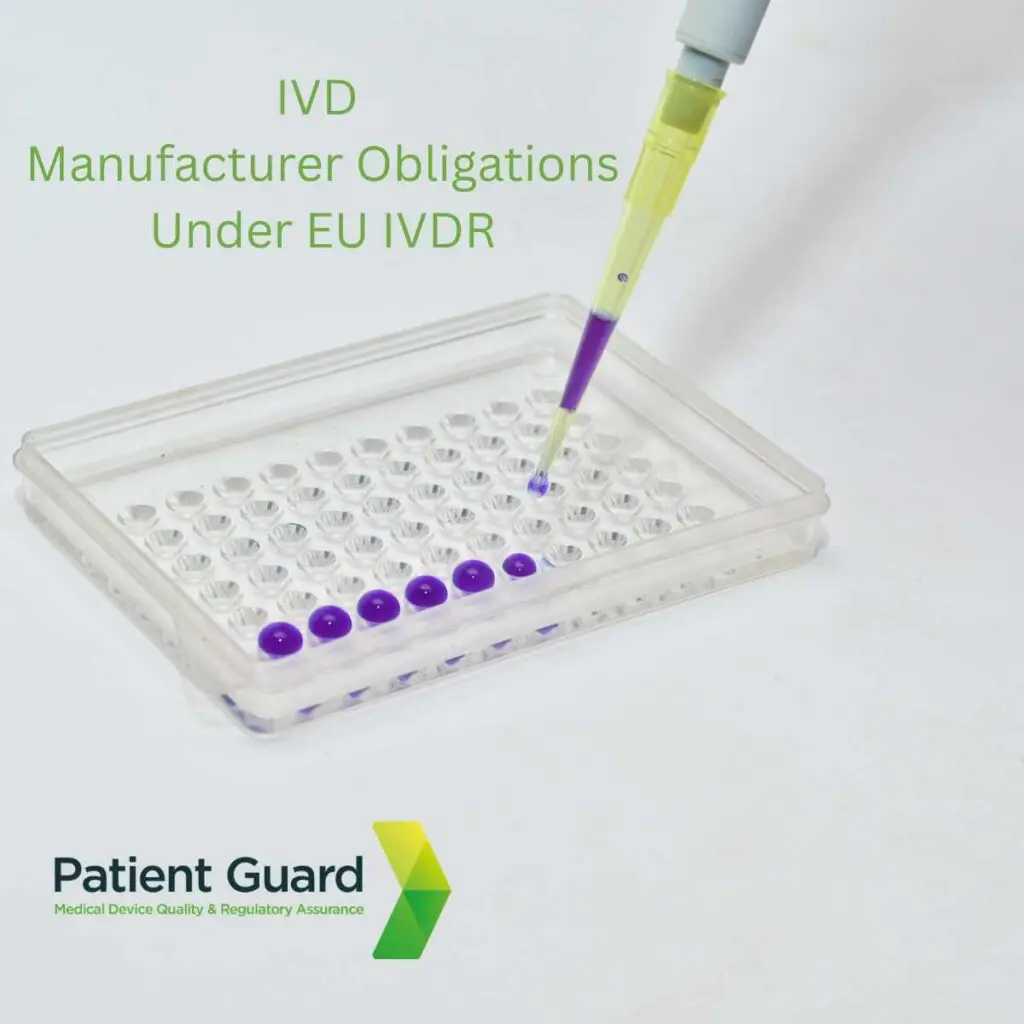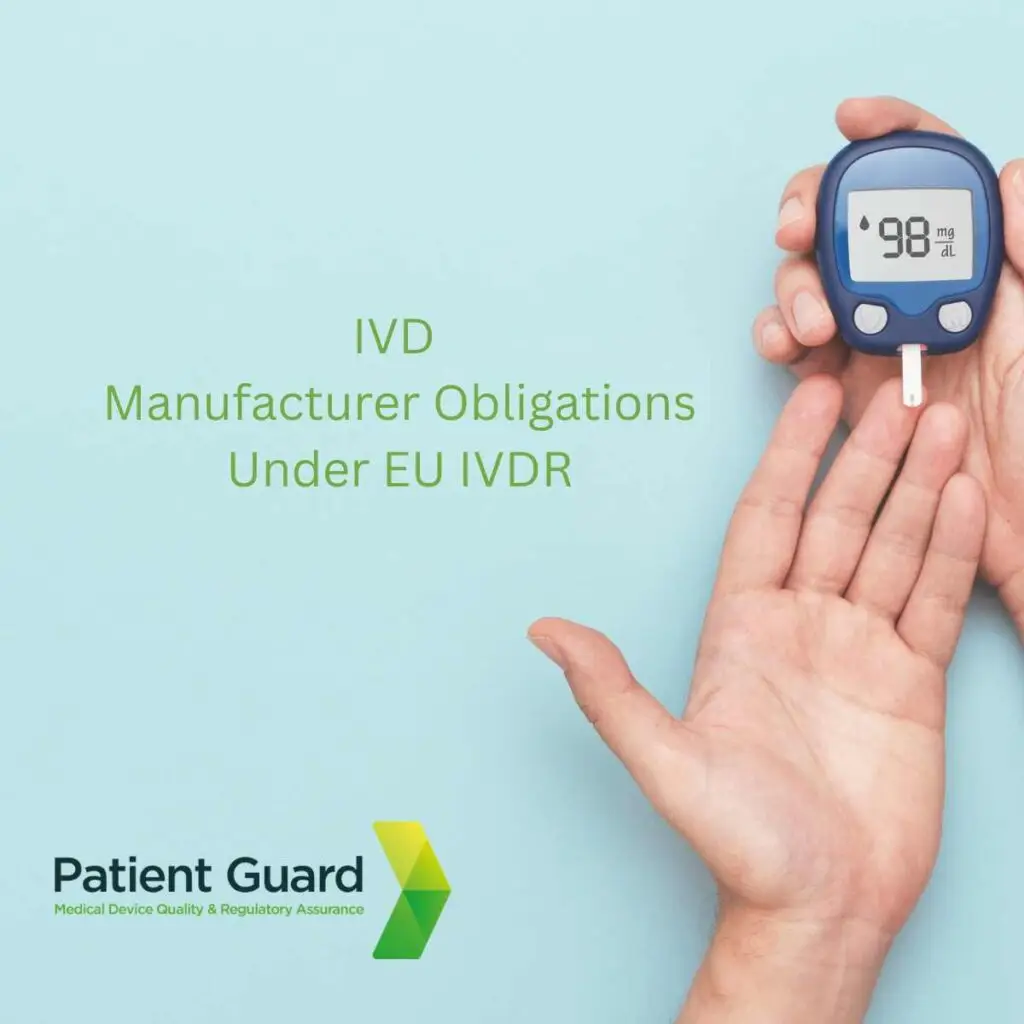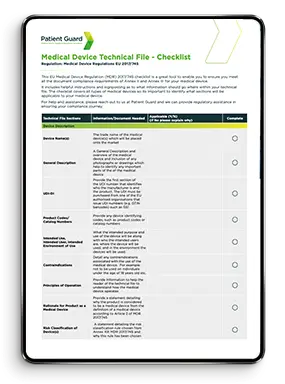What is Article 10 of the EU IVDR?
Article 10 of the IVDR specifies the baseline legal and procedural responsibilities of IVD manufacturers. These responsibilities span the entire lifecycle of an in vitro diagnostic device—from initial design and development to production, market placement, and post-market activities.
The goal of Article 10 is to ensure that manufacturers are proactive in managing device safety, performance, and regulatory compliance throughout the product’s lifecycle.

Core Responsibilities Under Article 10
1. Ensure Device Conformity with IVDR Requirements
Manufacturers must ensure that the IVDs they place on the market conform to the IVDR, particularly the General Safety and Performance Requirements (GSPRs) outlined in Annex I. This includes requirements on analytical and clinical performance, scientific validity, and risk management.
2. Implementation of a Quality Management System (QMS)
A compliant QMS is mandatory under Article 10(8). The QMS must cover:
Device design and development
Raw material and supplier controls
Production and final product inspection
Post-market surveillance
Incident reporting and corrective actions
The QMS must be proportionate to the risk class of the IVD (Class A to D) and should align with ISO 13485:2016 as a best practice.
3. Maintain Up-to-Date Technical Documentation
Manufacturers must maintain comprehensive technical documentation, including:
Device description and specifications
Analytical and clinical performance data
Risk-benefit analysis
Labeling and instructions for use (IFU)
This documentation must demonstrate conformity with the regulation and be accessible to Notified Bodies and competent authorities upon request.
4. Risk Management Throughout the Device Lifecycle
An IVD must be supported by a risk management system, as part of the QMS. This involves:
Identifying and assessing potential risks
Implementing control measures
Evaluating residual risks
Monitoring for new or emerging risks during real-world use
The risk management process must be ongoing and not limited to pre-market activities.
5. Establish a Post-Market Surveillance (PMS) System
Manufacturers must implement a PMS system to collect and assess data on device performance and safety once it is on the market. For Class B, C, and D devices, this includes a Post-Market Performance Follow-up (PMPF) plan and Periodic Safety Update Reports (PSURs).
The PMS findings must feed into the QMS, risk management, and performance evaluation processes.
6. Reporting of Serious Incidents and Field Safety Corrective Actions (FSCAs)
Article 10 requires manufacturers to report:
Serious incidents within the timeframes set out in Article 82
Field safety corrective actions (e.g. product recalls, software updates)
These reports must be submitted to competent authorities via EUDAMED, the central European database.
7. Appoint a Person Responsible for Regulatory Compliance (PRRC)
Each manufacturer must have at least one PRRC available, as required under Article 15. This person ensures compliance with:
Device conformity and documentation
PMS and vigilance obligations
Regulatory updates and changes
The PRRC must be qualified based on education and/or relevant professional experience.
8. Ensure Unique Device Identification (UDI) and Traceability
Manufacturers must assign a UDI to each IVD and ensure it is included in product labelling and registered in the EUDAMED database. This supports traceability, recall efficiency, and post-market monitoring.
9. Have Adequate Liability Insurance Coverage
Manufacturers are required to have sufficient financial coverage or liability insurance to ensure compensation for harm caused by defective devices. This is particularly relevant for higher-risk IVDs (e.g. Class C and D).
Why Article 10 Matters
Article 10 is not an isolated requirement; it is the foundation of IVDR compliance. Every other article—whether on performance evaluation, PMS, or conformity assessment—relates in some way to the manufacturer’s obligations laid out in Article 10.
With the shift from the IVDD to IVDR, many devices now face up-classification, bringing stricter scrutiny, especially from Notified Bodies. Article 10 ensures that manufacturers are systematically prepared for the lifecycle demands of their devices under this new paradigm.
Frequently Asked Questions (FAQs)
Yes. Article 10 requires all manufacturers to establish and maintain a QMS. Although Class A devices are subject to lower oversight, a documented QMS covering design, production, and post-market activities is still mandatory.
A PRRC must have:
A university degree in a relevant field (medicine, pharmacy, law, engineering, science) and one year of regulatory experience, or
Four years of professional experience in regulatory affairs or quality management related to IVDs.
Failure to comply with Article 10 can lead to:
Suspension or withdrawal of CE certificates
Market recall or prohibition
Legal and financial liability
Reputation damage
Regulatory enforcement actions
Manufacturers based outside the EU must appoint an EU Authorised Representative who acts on their behalf. However, the core obligations under Article 10 still apply to them, including QMS implementation, technical documentation, PMS, and vigilance.
Summary
Article 10 of the EU IVDR is central to ensuring that IVDs placed on the EU market are safe, effective, and fully compliant with regulatory expectations. For manufacturers, it represents a call to build robust systems that support device performance, risk management, and traceability.
At Patient Guard, we support IVD manufacturers across all device classes to meet their Article 10 obligations—from QMS development and PMS planning to acting as your EU Authorised Representative.
Need expert support to achieve or maintain IVDR compliance? Contact our team today to learn more.
Resources
- Navigating the EU Medical Device Regulatory Roadmap: A Guide for Manufacturers
- The Role of Notified Bodies in Medical Device Certification
- Understanding the EU MDR General Safety and Performance Requirements (GSPRs)
- Understanding Article 10 of EU MDR 2017/745: Manufacturers’ Obligations Explained
- The Biological Evaluation of Medical Devices
- IVDR for Beginners: A Comprehensive Guide for Newcomers
- EU MDR for Beginners: Understanding the Basics of the EU Medical Device Regulation




